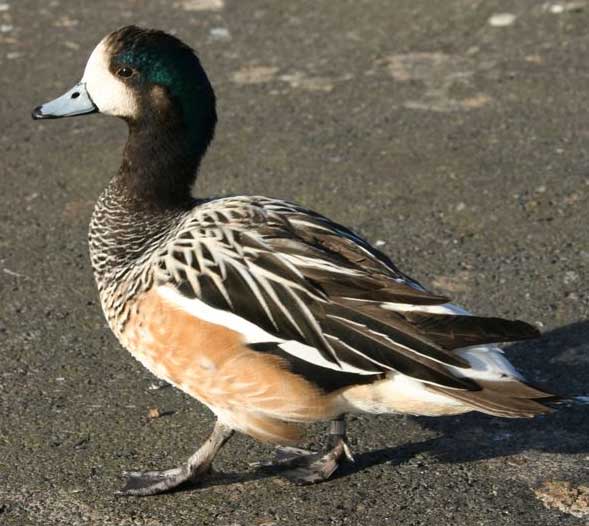
Mareca sibilatrix, Photo: Duncan Wright (*)
Superregnum: Eukaryota
Cladus: Unikonta
Cladus: Opisthokonta
Cladus: Holozoa
Regnum: Animalia
Subregnum: Eumetazoa
Cladus: Bilateria
Cladus: Nephrozoa
Superphylum: Deuterostomia
Phylum: Chordata
Subphylum: Vertebrata
Infraphylum: Gnathostomata
Megaclassis: Osteichthyes
Cladus: Sarcopterygii
Cladus: Rhipidistia
Cladus: Tetrapodomorpha
Cladus: Eotetrapodiformes
Cladus: Elpistostegalia
Superclassis: Tetrapoda
Cladus: Reptiliomorpha
Cladus: Amniota
Classis: Reptilia
Cladus: Eureptilia
Cladus: Romeriida
Subclassis: Diapsida
Cladus: Sauria
Infraclassis: Archosauromorpha
Cladus: Crurotarsi
Divisio: Archosauria
Cladus: Avemetatarsalia
Cladus: Ornithodira
Subtaxon: Dinosauromorpha
Cladus: Dinosauriformes
Cladus: Dracohors
Cladus: Dinosauria
Ordo: Saurischia
Cladus: Eusaurischia
Subordo: Theropoda
Cladus: Neotheropoda
Cladus: Averostra
Cladus: Tetanurae
Cladus: Avetheropoda
Cladus: Coelurosauria
Cladus: Tyrannoraptora
Cladus: Maniraptoromorpha
Cladus: Maniraptoriformes
Cladus: Maniraptora
Cladus: Pennaraptora
Cladus: Paraves
Cladus: Eumaniraptora
Cladus: Avialae
Infraclassis: Aves
Cladus: Euavialae
Cladus: Avebrevicauda
Cladus: Pygostylia
Cladus: Ornithothoraces
Cladus: Ornithuromorpha
Cladus: Carinatae
Parvclassis: Neornithes
Cohors: Neognathae
Cladus: Pangalloanserae
Cladus: Galloanseres
Ordo: Anseriformes
Familia: Anatidae
Genus: Mareca
Species: Mareca sibilatrix
Name
Mareca sibilatrix (Poeppig, 1829)
Synonymy
Anas sibilatrix (protonym)
References
Notizen aus dem Gebiete der Natur- und Heilkunde [Froriep] 25: col.10.
Vernacular names
العربية: ودجون تشيلوي
català: Ànec xiulador sud-americà
čeština: Hvízdák chilský
Cymraeg: Chwiwell Magellan
dansk: Chilepibeand
Deutsch: Chilepfeifente
English: Chiloe Wigeon
Esperanto: Sudamerika fajfanaso
español: Silbón overo
suomi: Patagonianhaapana
français: Canard de Chiloé
हिन्दी: चिलोए पतेरा
magyar: Chilei fütyülőréce
italiano: Fischione del Cile
日本語: ワキアカヒドリ
Plattdüütsch: Chileenschen Smunt
Nederlands: Chileense Smient
norsk: Sørblesand
polski: Świstun chilijski
português: Marreca-oveira
русский: Роскошная свиязь
svenska: Chilebläsand
Tiếng Việt: Vịt trời Chiloé
The Chiloé wigeon (Mareca sibilatrix), also known as the southern wigeon, is one of three extant species of wigeon in the genus Mareca of the dabbling duck subfamily. This bird is indigenous to the southern part of South America, including the Chiloé Archipelago. In its native range, it is called the pato overo ("piebald duck") or pato real ("royal duck"), although the latter name also refers to the Muscovy in the wild. Its specific epithet, sibilatrix, means 'whistler', referring to the bird's call.
Contents
1 Description
2 Distribution and habitat
3 Ecology and behavior
4 References
5 Works cited
6 External links
Description
A male
The Chiloé wigeon has a body length of 46 to 56 cm (18 to 22 in) and a wingspan of 75 to 86 cm (30 to 34 in). The wing length is about 25 cm (9.8 in) and the weight is approximately 800 g (28 oz).[2][3]
This bird has an iridescent green-blue cap on its head, and a bluish gray bill with a black tip. The cheeks and forehead are white, the eyes are dark brown, and there is a white auricular patch. The neck and occipital part of the head are black. The breast is barred black and white and the plumage of the wings is gray and white. The flanks of males are rust colored, and light brown on females. The legs and feet are gray.
Sexual dimorphism is relatively subtle in this species of wigeon. Males are usually somewhat larger and heavier, and with somewhat brighter plumage and more strongly pronounced iridescence of the cap. Apart from these features, it can be difficult to distinguish the two sexes.[4] Juveniles resemble adult birds, but the rust coloring on the flanks is diminished or absent.
Distribution and habitat
Swimming Chiloé wigeon
This duck is indigenous to the southern part of South America, where it is found on freshwater lakes, marshes, shallow lagoons and slow flowing rivers. Vagrants have been observed in South Georgia, South Orkney and the South Shetland Islands.
It breeds primarily in Argentina, Uruguay, and Chile. The northern border of the breeding range is in Argentina at 36° S and Chile at 40° S. It also breeds sparingly in the Falkland Islands.[5] It migrates to southeastern Brazil for the winter.[6]
It was first introduced to Europe in 1870; it soon bred in zoos.
Because the Chiloé wigeon is widely distributed and has a large, stable wild population, it is categorized as least concern by the IUCN.[1]
Ecology and behavior
A family in Patagonia, Chile
Searching for food
Mareca sibilatrix - MHNT
The Chiloé wigeon displays a variety of behaviors depending on habitat. It is an omnivore, feeding predominantly on aquatic plants and grass, and occasionally coastal algae.[4]
This monogamous species breeds in the austral spring, between September and December. Pairs inhabit very small breeding territories, building their nests in grasses and under bushes. The female lays eight to ten white or cream-colored eggs. After a gestation period of approximately 24–25 days the ducklings are born. The father helps raise the ducklings; however, he leaves the family after the offspring molt.
Captive hybrids with the Philippine Duck (Anas luzonica) have been described.[7]
References
BirdLife International (2016). "Mareca sibilatrix". IUCN Red List of Threatened Species. 2016: e.T22680167A92847550. doi:10.2305/IUCN.UK.2016-3.RLTS.T22680167A92847550.en. Retrieved 12 November 2021.
Heinzel, H; Fitter, RSR; Parslow, JLF (1979). The birds of Britain and Europe with North Africa and the Middle East (4th ed.). London: Collins. p. 52. ISBN 978-0002192347.
Ogilvie, MA; Young, S (1999). Photographic handbook of the wildfowl of the world. Frenchs Forest, New South Wales: New Holland Books. ISBN 978-1853686252.
Shirihai H: A Complete Guide to Antarctic Wildlife - The Birds and Marine Mammals of the Antarctic Continent and Southern Ocean, Alula Press, Degerby 2002, p. 247. ISBN 951-98947-0-5
Wood, p. 86
Clements J (2007) The Clements Checklist of the Birds of the World, Cornell University Press, Ithaca
Ottenburghs, Jente; Harteman, Jan (2021). "Sexually dichromatic hybrids between two monochromatic duck species, the Chiloé wigeon and the Philippine duck". Ecology and Evolution. 11 (23): 16409–16412. doi:10.1002/ece3.8253. ISSN 2045-7758. PMC 8668737. PMID 34938444.
Works cited
Kolbe, Hartmut; The Ducks of the World, Ulmer Verlag 1999, ISBN 3-8001-7442-1
Woods, A, Woods, R: Atlas of Breeding Birds of the Falkland Islands, Anthony Nelson, Shorpshire 1997, ISBN 0-904614-60-3
Retrieved from "http://en.wikipedia.org/"
All text is available under the terms of the GNU Free Documentation License

